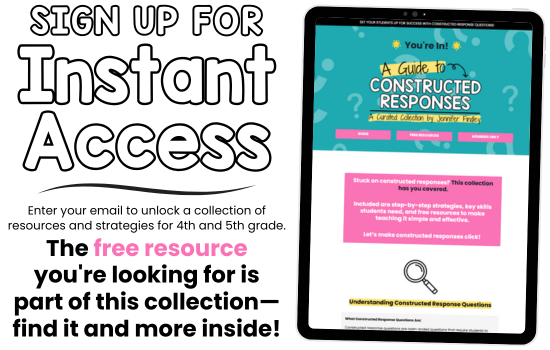Why Do Constructed Response Questions Feel So Hard for Students?
If you’ve ever seen a student leave a constructed response blank or fill it with random thoughts, you know exactly what I mean.
Unlike multiple-choice questions, which give students a “hint” with answer choices, constructed responses take away that safety net.
Suddenly, students are on their own. And without those options to guide them, they need a whole new set of skills to figure things out. Let’s break down why constructed responses can be such a challenge—and what students need to handle them confidently.
So, What Skills Do Students Actually Need?
Constructed responses are all about digging into the text and making their thinking visible. There’s no room for guessing here.
Here’s a closer look at the skills students need to tackle these questions head-on.
1. Can Students Really Understand the Passage?
For constructed response questions, surface-level reading just doesn’t cut it.
Students need to understand the passage on a deeper level, especially if the question’s more rigorous. The harder the question, the more thorough their understanding has to be.
If a question asks about theme, for example, students might need to understand not just the basic story elements but how those elements actually shape the theme.
If we’re asking tough questions, our students need to have the skills to match that level of rigor.
2. Do They Really Get What the Question Wants?
Without multiple-choice options, students have to figure out what the question is actually asking, which can be harder than it sounds.
I’ve had students turn in blank answers when we first moved away from multiple-choice questions, simply because they couldn’t understand what the question was even asking for.
It’s easy to overlook this, but learning to interpret a question on their own is an essential skill. If they don’t know what’s being asked, they can’t answer it—plain and simple.
3. Can They Find the Right Evidence in the Text?
Once students know what the question wants, the next challenge is going back to the text to find evidence.
This can be especially tough when the answer isn’t obvious, and they have to piece it together from different parts of the passage.
It’s not always about “knowing” the answer right away; sometimes they have to “uncover” it by pulling out relevant details. And honestly, that process can feel like a big leap if they’re not used to it.
4. Can They Organize Their Answer?
Even if students know the answer and have the evidence, they still need to structure their response so it flows and makes sense.
It’s one thing to understand it in their heads; it’s another to get it on paper in a clear, organized way. This is where many students stumble. They need practice pulling in evidence, thinking through their points, and writing it all out in a way that’s logical and easy to follow.
5. Can They Show How Their Evidence Supports Their Answer?
Finally, they need to tie it all together by explaining how their evidence actually supports their answer.
This is where things get tricky. Students might “know” the answer and find the evidence, but now they need to make the connection and spell out their reasoning.
This last step can feel like a whole new level for many students because it requires them to think critically and communicate clearly.
Breaking down these skills helps us see where our students might need extra support. It’s a step-by-step process, and each skill builds on the last. With the right practice, we can give students the tools they need to take on constructed response questions with confidence.
For access to my FREE constructed response collection, click on the image below. You will be taken to a webpage where you can enter your email to unlock access to the resources. The collection includes the freebie shown in this blog post, along with other resources for teaching and practicing constructed responses in 4th and 5th grade.








Leave a Comment